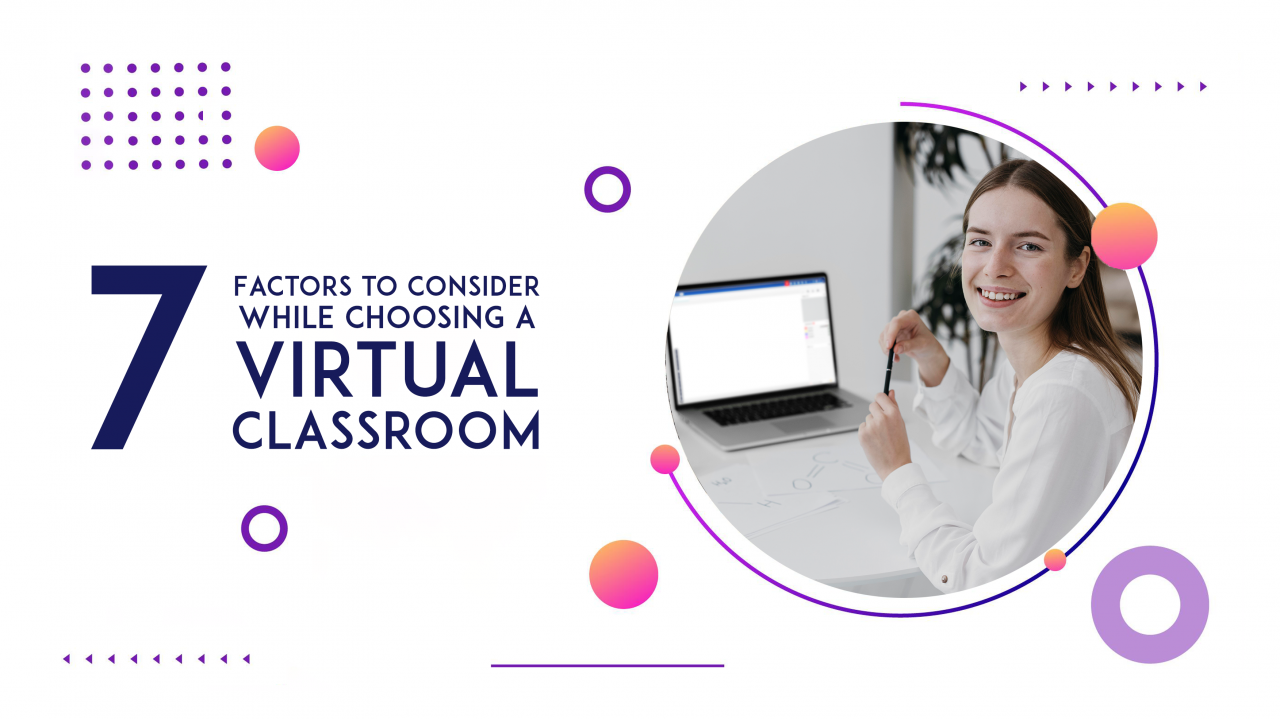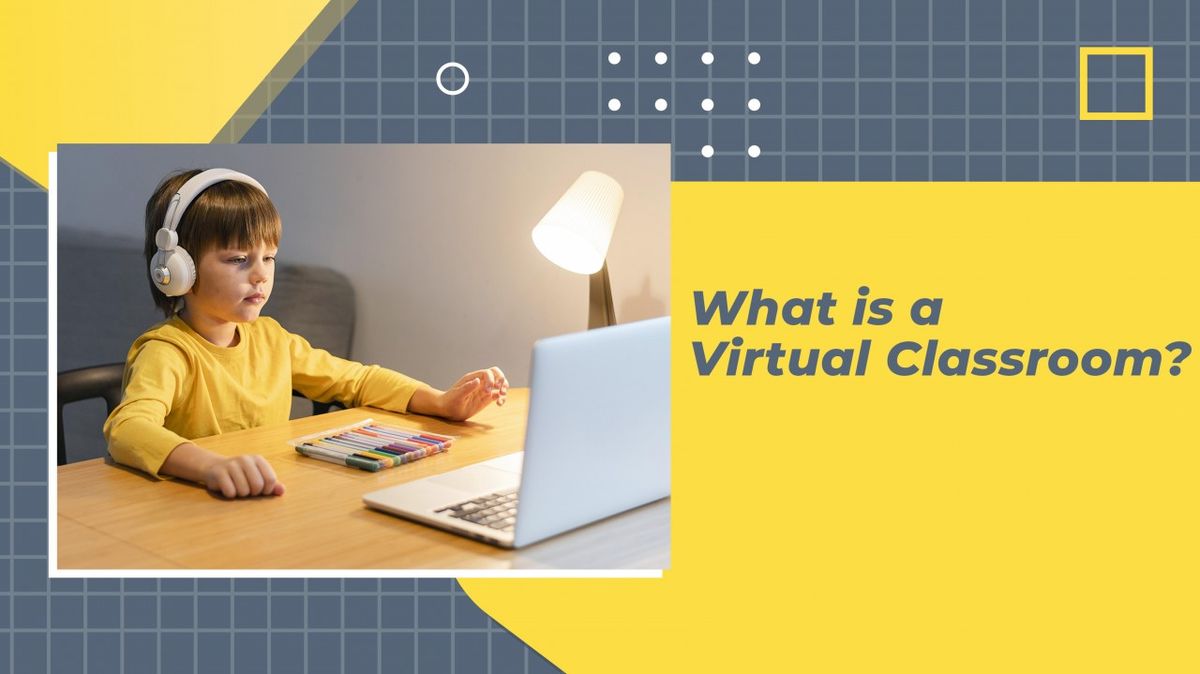Virtual learning has been gaining popularity in the education industry since the last decade. In a report published by Research & Markets in 2019, it was projected that the global online education market would reach US$ 350 Billion by 2025. But with the onset of the Covid-19 pandemic that forced schools, universities, and companies to remote working, virtual learning has gained more traction in the education industry than ever.
With the strict lockdowns, travel restrictions & social distancing rules that are in place, organizations & educational institutions across the globe are forced to switch to distance learning to deliver necessary training. And the demand for virtual classroom platforms is at an all-time high.
But how do you identify a virtual classroom platform that can cater to your unique training requirements?
Here are the seven factors to consider while choosing the right virtual classroom platform

1. Video/Audio conferencing potential
One of the prominent reasons for the widespread acceptance of virtual classrooms is because it creates a virtual replica of a traditional classroom where instructors & learners get to interact. This is possible in a virtual environment because virtual classroom platforms are deep-rooted in video conferencing functionality.
This is why the video conferencing potential of a virtual classroom has to be a decisive parameter in making a purchase decision.
Here is how you determine the video/audio conferencing potential of a virtual classroom platform.
Know the technology the provider uses for video conferencing: While it might seem to be Greek & Latin to a non-technical person, it's advisable to do the legwork on the technologies a video conferencing platform use. For instance, we'd reccomend investing in a software that uses a deep SFU/MCU WebRTC engine powered by Simulcast to deliver the best quality video streams to all attendees in a classroom.
Supported number of attendees in a classroom: While most virtual classroom providers can support an unlimited number of attendees in a room, the decisive parameter has to be the latency of the network. The last thing you want in a virtual classroom is a delay.
Datacenter: Datacenter act as a central point of access for data in virtual classrooms and the kind of data centre the virtual classroom provider has to be a decisive factor before you decide to purchase. Ideally, you need a virtual classroom software lets users host sessions in a minimum of 10 low-latency edge locations worldwide.
2. Interactive features
While video/audio conferencing plays a crucial role in the virtual learning environment, the interactive features offered by virtual classroom platforms are what creates a collaborative classroom environment.
Here are the must-have interactive features in a virtual classroom
Whiteboard: Interactive whiteboards in virtual classroom platforms play a crucial role in creating a collaborative virtual classroom environment. It is important to have a whiteboard that lets both the instructors & learners write, draw, & share content.
Multiple screen share option: While screen share is a standard feature offered by virtual classroom platform providers, what you need to look for is whether or not they provide a multiple screen share option.
Content sharing feature: A virtual classroom platform should let both instructors & learners share content in a collaborative environment. An ideal virtual classroom platform would let instructors & learners' share image, video & text contents from the cloud, computer or online platforms.
Centralized control: For a virtual learning environment to be productive, the instructors must get to control the attendees. Ideally, before making a purchase decision, ensure that the virtual classroom platform you opt for comes with an option for centralized control. For instance, the instructor (host) should have the option to turn on/off the mic, camera, & screen share, provide/revoke screen share, private chat access, and more.
3. Mobile/Tablet support
The flexibility offered by the virtual classroom platforms is another prominent reason for its popularity. Having mobile/tablet support can be equally beneficial to the instructors & students alike.
Mobile/table support comes in two ways
Browser-based support: Browser-based virtual classroom platform is a cloud-based HTML5 virtual classroom that lets users join & host virtual classrooms from Android and Apple iOS-based devices only using a supported browser without installing any app. This can especially come in handy when you don't want to spend more on the application but want to retain all the features of the platform on mobile devices.
App-based support: This is where users have to download the mobile application of the platform & register on it to join/host classrooms.
If flexibility is what you want, we recommend you to go ahead with an HTML5 (Browser-based support) platform.
4. Instant communication tools
Communication between instructors & students is important in a virtual classroom environment. This is where instant communication tools like chatbox can come in handy. While chat feature is commonly found in all virtual classroom platforms, what you need to look for is whether or not it has options for private chat?
5. Breakout rooms
For a classroom environment to be productive, the learners must get to interact among themselves in a controlled environment. This is what breakout rooms do in a virtual classroom. Ideally, you should only invest in a virtual classroom platform that offers a breakout room feature.
If your virtual classroom platform has breakout rooms, instructors can split the learners into small groups and let them interact among themselves under a controlled environment. This can especially come in handy when instructors need the learners to have a brainstorming session and come out with some ideas or suggestions.
6. Number of participants allowed
Different platforms offer a different number of maximum participants in a classroom environment. So, before you invest your money on a platform, ensure that the platform can support the number of participants you want.
It is also important to check whether the platform makes use of adequate technologies & has an adequate number of global data-centre locations to give you a low latency experience in the classroom.
7. Recording options
While virtual classroom platforms offer an asynchronous learning experience, sometimes the instructor might have to record the classroom session & upload it in their LMS. Contrary to popular opinion, recording a classroom session using a third party application isn't a viable option. This is where having an option to do server-side recordings can come in handy.
With server-side recording, you can ensure that you get to record the entire session in the original clarity. Apart from this, the recordings are automatically stored in the cloud making it easier for you to integrate them with your LMS or share it with someone.
To sum up
These 7 pointers mentioned in the article are the important factors you need to consider while investing in a virtual classroom platform. If you are still confused about making a purchase decision, get in touch with our customer support team for any assistance.











